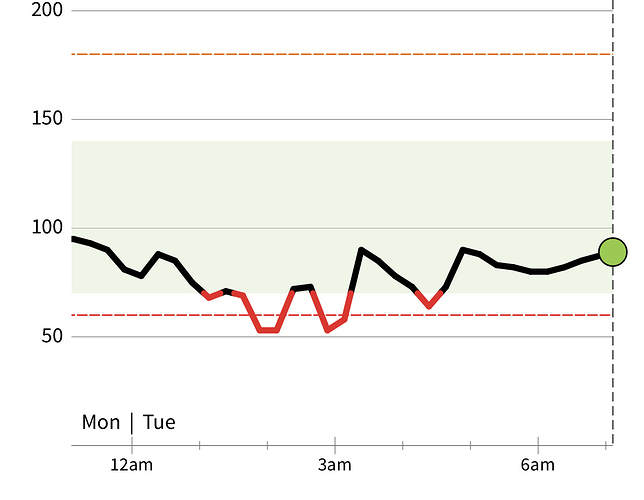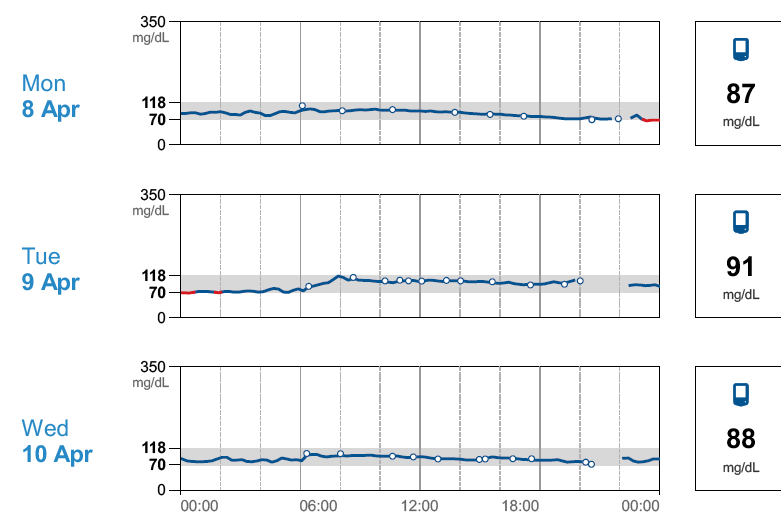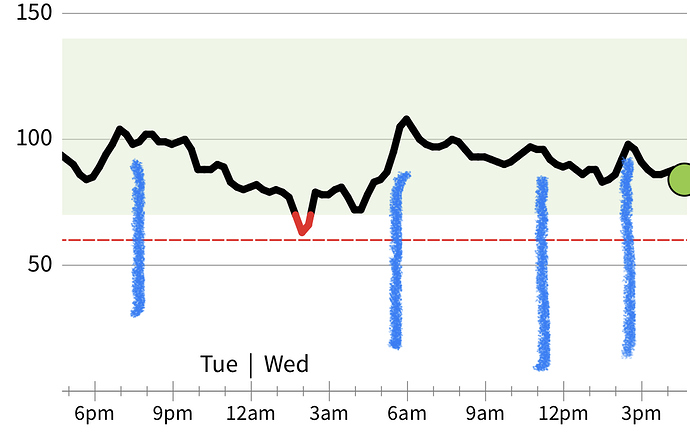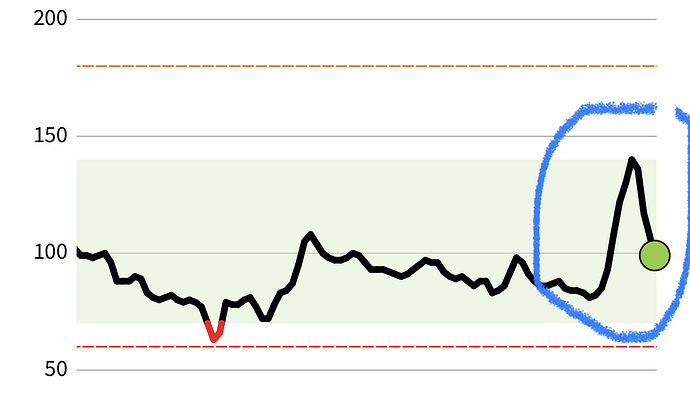Normally my blood glucose drops to like 70-80 at night with a few excursions to the 60s but last night was mildly scary. What might be the cause? Yesterday was more or less a normal day. I did exercise in the early afternoon instead of the AM.
Nocturnal hypoglycemia CGM
So I guess that’s from a CGM… many have reported “compression lows” where laying with the sensor pressed into the mattress has caused ultra low readings… might you be experiencing something similar?
I’ve wondered about that too. Do you sleep on your side/arm? Unfortunately, there’s no way to actually test this.
My blood sugar always hit its lowest at night.
Which monitor are you using?
That is an awfully long time to have compression in one spot. I doubt i am that still… It doesn’t take any time at all to get back to the high 80s low 90s. Just standing up does that and I am pretty sure I must have gotten up briefly once or twice. Oh well, will monitor.
Are you experiencing any symptoms of hypoglycaemia? Remember that when there are ketones to take up the slack, the brain is fine with very low glucose intake. (I even seem to remember Prof. Bikman saying something in an interview to the effect that the brain actually seems to prefer ketones when it can get them.)
The brain does appear to need some glucose (even Bikman doesn’t seem to be challenging that idea anymore), but it was shown in George Cahill’s fasting study in the 1960’s that fasting subjects with elevated ketones could have their glucose driven down (by means of a hyperinsulinaemic euglycaemic clamp) to levels that would ordinarily cause coma or death, all with no ill effects, because there were enough ketones available to feed their brains. As Stephen Phinney once put it in a lecture, “The only people who were sweating and trembling were the ones in the white lab coats.”
So if these lows are not artefacts of some problem with the monitor, as other posters have suggested, I don’t believe they are a problem, unless you are experiencing symptoms. We get posts periodically from ketotic members who have readings even lower than you are showing, and the only way they knew was because they happened to be monitoring. Despite the low measurements, they felt fine.
Common symptoms may include:
Fast heartbeat.
Shaking.
Sweating.
Nervousness or anxiety.
Irritability or confusion.
Dizziness.
Hunger.
Nope… None of the above… So I guess I am good.
Thanks for the comments, I was unaware of the potential compressional low issue
The graphs are from the app. I download the data through the website to make my own graphs/nerdiness. Here is an example report from the website illustrating the one super big carby meal I had at a Michel * restaurant…no doubt similar to the one I have planned at Arnaud’s in New Orleans tomorrow night (ending on Bananas Foster) along with my one low night
Yeah, I move quite a bit.
Speaking of movement, the graphs you show have more variation than the ones I have. I’m not sure if that’s because they do (your blood sugar moves more than mine did), my software wasn’t great (which it wasn’t), or what. One difference is that you can “blow up” the scale. See mine for instance:
This scale goes from 0-350. I really don’t need anywhere above 200, and really would like to see what’s going on in 70-120. My software didn’t allow this, though.
Actually it looks like you have the Libre 2 right?
I zoom two different ways. One I just take those images and zoom in using ctrl shift s on a pc (something similar on mac) or just use the phone screen grab like below
But better is to go to Libre.com and log in. They have great reports but on the top right of the homemm by page you have an option to download Al the data to excel and do as you wish
This has actually gotten worse. This is the last 24 hours with blue lines everywhere I eat something. I get a small kick upwards on eating but then it starts to fall. I even ate a snack at 3:00 this afternoon as it was 71 and falling. Big carby meal tonight in the French Quarter so that will be interesting.
I definitely have more variability than I did a few weeks ago. Maybe it is a bad sensor?!?! Or I am getting super insulin insensitive.
I had the FreeStyle Libre, but I got the initial supply from Sweden. The version I showed is the US version, but I only wore that for not too long. It’s too expensive without insurance.
Not sure but a friend pays less than $40 a sensor at Costco with the member discount. Still expensive I realize and you need a prescription. Meanwhile you seem to show very little variation so I am not sure what additional information it can provide if you are not diabetic
I would actually expect someone to start showing very little variation shortly after the carb intake is cut, the only real swings after that being from eating more carbohydrate and the insulin response to it.
I got them at HEB and they were 200$ for 6 still over 2$/ day. Don’t think I will get six more but I am not sure now and that lovely meal at Arnaud’s including French bread and splitting a dessert?
Sure it jumped up a bit (briefly to 140) but then back down as quickly. It is the lows at night that concern me. The alarm went off with a 53 value and that is no good
No, it doesn’t. The swings on the graph show that something is going on. What did you eat to produce the peak circled in blue? And was there a lower low than usual afterward? If so, that would be a sign that you are still insulin-resistant, because a deep trough indicates excessive insulin secretion.
That’s one issue. The second issue is that of whether serum glucose at 53 is a bad situation or not. As I tried to explain in my earlier post, if you are in ketosis, then a dip like that doesn’t matter, because you are making ketones to supply your brain. George Cahill drove down his subjects’ glucose even lower than that, and they were fine. The had been fasting for several days, and their ketones were elevated. As Dr. Phinney once joked, the only people sweating and trembling during that experiment were the ones in the white coats.
On the other hand, if you are eating enough glucose (i.e., carbohydrate) to trigger a large insulin release, then the elevated insulin is going to shut off ketogenesis. That means that if the amount of insulin released is sufficiently large, you will experience reactive hypoglycaemia, and in the absence of ketones to feed the brain, you will be in trouble. The only solution at that point is to eat more glucose, which will provoke a further insulin spike and further reactive hypoglycaemia, and so on. Sticking to a diet sufficiently low in carbohydrate to avoid an insulin spike, and sufficiently high in fat to provide enough energy for the brain, will avoid these large fluctuations. Fat does not affect insulin, so it is a safer source of energy than carbohydrate.






